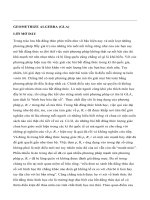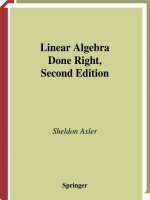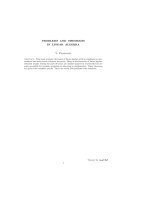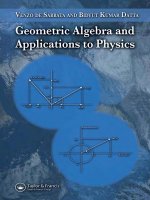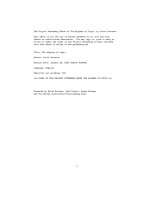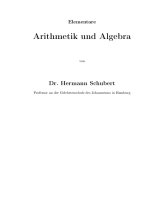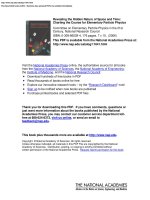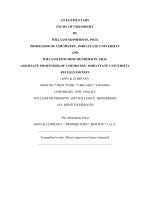Elementary algebra
Bạn đang xem bản rút gọn của tài liệu. Xem và tải ngay bản đầy đủ của tài liệu tại đây (7.39 MB, 564 trang )
Rectangle
Triangle
w
a
c
h
l
A=lw
A
P
l
w
P = 2 l + 2w
area
perimeter
length
width
Parallelogram
b
A = 1 bh
2
A area
P perimeter
b base
h altitude
a, c sides
P=a+b+c
Right Triangle
h
c
b
A = bh
A area
b base
h altitude ( height)
Trapezoid
b
a
Pythagorean theorem: a2 + b2 = c2
a, b legs
c hypotenuse
Circle
b1
h
r
b2
A = 1 h (b1 + b2 )
2
A area
b1, b2 bases
h altitude
A = πr2
C = 2 πr
A area
C circumference
r radius
Cube
Rectangular Prism
b
s
s
s
V = s3
c
S = 6s2
V
S
s
a
volume
total surface area
length of a side
Sphere
V = abc
S = 2 ac + 2 ab + 2bc
V
S
a
b
c
volume
total surface area
width
length
height
Right Circular Cylinder
r
r
V = 4 πr 3
3
V
S
r
S = 4πr 2
h
V = πr 2h
S = 2 πr 2 + 2π rh
V
S
r
h
volume
total surface area
radius
altitude (height)
volume
total surface area
radius
Pyramid
Right Circular Cone
h
r
base
V
B
h
V = 1 Bh
3
volume
area of base
altitude ( height)
s
h
V = 1 πr 2 h
3
V
S
r
h
s
S = πr 2 + πr s
volume
total surface area
radius
altitude (height)
slant height
ELEMENTARY
ALGEBRA
NINTH EDITION
This page intentionally left blank
NINTH
EDITION
ELEMENTARY
ALGEBRA
Jerome E. Kaufmann
Karen L. Schwitters
Seminole State College of Florida
Australia • Brazil • Japan • Korea • Mexico • Singapore • Spain • United Kingdom • United States
Elementary Algebra, Ninth Edition
Jerome E. Kaufmann and Karen L. Schwitters
Mathematics Editor: Marc Bove
Developmental Editor: Meaghan Banks
Assistant Editor: Stefanie Beeck
Editorial Assistant: Kyle O’Loughlin
© 2011, 2007 Brooks/Cole, Cengage Learning
ALL RIGHTS RESERVED. No part of this work covered by the copyright
herein may be reproduced, transmitted, stored, or used in any form or by
any means graphic, electronic, or mechanical, including but not limited to
photocopying, recording, scanning, digitizing, taping, Web distribution,
information networks, or information storage and retrieval systems,
except as permitted under Section 107 or 108 of the 1976 United States
Copyright Act, without the prior written permission of the publisher.
Media Editor: Maureen Ross
Marketing Manager: Joe Rogove
For product information and technology assistance, contact us at
Cengage Learning Customer & Sales Support, 1-800-354-9706
Marketing Assistant: Angela Kim
Marketing Communications Manager: Katy Malatesta
Content Project Manager: Tanya Nigh
Creative Director: Rob Hugel
For permission to use material from this text or product, submit all
requests online at www.cengage.com/permissions
Further permissions questions can be e-mailed to
Senior Art Director: Vernon Boes
Print Buyer: Karen Hunt
Rights Acquisitions Account Manager, Text: Timothy Sisler
Rights Acquisitions Account Manager, Image: Dan Schlotman
Production Service: Susan Graham
Text Designer: Diane Beasley
Copy Editor: Susan Graham
Illustrator: Network Graphics
Cover Designer: Irene Morris
Cover Image: Fotolia
Library of Congress Control Number: 2009926193
Student Edition:
ISBN-13: 978-1-4390-4917-4
ISBN-10: 1-4390-4917-3
Brooks/Cole
20 Davis Drive
Belmont, CA 94002-3098
USA
Cengage Learning is a leading provider of customized learning solutions
with office locations around the globe, including Singapore, the United
Kingdom, Australia, Mexico, Brazil, and Japan. Locate your local office at
www.cengage.com/global
Compositor: MacMillan Publishing Services
Cengage Learning products are represented in Canada by
Nelson Education, Ltd.
To learn more about Brooks/Cole, visit www.cengage.com/brooks/cole
Purchase any of our products at your local college store or at our preferred
online store www.ichapters.com
Printed in the United States of America
1 2 3 4 5 6 7 13 12 11 10 09
CONTENTS
1
Some Basic Concepts of Arithmetic and Algebra 1
1.1
Numerical and Algebraic Expressions
1.2
Prime and Composite Numbers
1.3
Integers: Addition and Subtraction
1.4
Integers: Multiplication and Division
1.5
Use of Properties
Chapter 1 Summary
2
8
14
21
26
35
Chapter 1 Review Problem Set
Chapter 1 Test
2
37
39
Real Numbers 41
2.1
Rational Numbers: Multiplication and Division
42
2.2
Addition and Subtraction of Rational Numbers
50
2.3
Real Numbers and Algebraic Expressions
2.4
Exponents
2.5
Translating from English to Algebra
69
Chapter 2 Summary
75
82
Chapter 2 Review Problem Set
Chapter 2 Test
85
87
Chapters 1 – 2 Cumulative Review Problem Set
3
59
88
Equations, Inequalities, and Problem Solving 91
3.1
Solving First-Degree Equations
92
3.2
Equations and Problem Solving
97
3.3
More on Solving Equations and Problem Solving
3.4
Equations Involving Parentheses and Fractional Forms
3.5
Inequalities
3.6
Inequalities, Compound Inequalities, and Problem Solving
111
120
Chapter 3 Summary
127
135
Chapter 3 Review Problem Set
Chapter 3 Test
103
139
141
v
vi
Contents
4
Formulas and Problem Solving 143
4.1
Ratio, Proportion, and Percent
4.2
More on Percents and Problem Solving
4.3
Formulas
4.4
Problem Solving
4.5
More about Problem Solving
152
158
Chapter 4 Summary
167
172
178
Chapter 4 Review Problem Set
Chapter 4 Test
144
181
182
Chapters 1 – 4 Cumulative Review Problem Set
5
183
Exponents and Polynomials 185
5.1
Addition and Subtraction of Polynomials
5.2
Multiplying Monomials
5.3
Multiplying Polynomials
5.4
Dividing by Monomials
5.5
Dividing by Binomials
5.6
Integral Exponents and Scientific Notation
Chapter 5 Summary
192
197
204
208
212
220
Chapter 5 Review Problem Set
Chapter 5 Test
186
223
225
Chapters 1 – 5 Cumulative Review Problem Set
6
Factoring, Solving Equations, and Problem Solving 229
6.1
Factoring by Using the Distributive Property
6.2
Factoring the Difference of Two Squares
6.3
Factoring Trinomials of the Form x ϩ bx ϩ c
6.4
Factoring Trinomials of the Form ax ϩ bx ϩ c
6.5
Factoring, Solving Equations, and Problem Solving
2
242
249
255
264
Chapter 6 Review Problem Set
Chapter 6 Test
230
236
2
Chapter 6 Summary
7
226
266
268
Algebraic Fractions 269
7.1
Simplifying Algebraic Fractions
7.2
Multiplying and Dividing Algebraic Fractions
7.3
Adding and Subtracting Algebraic Fractions
7.4
Addition and Subtraction of Algebraic Fractions and Simplifying Complex Fractions
270
274
278
284
Contents
7.5
Fractional Equations and Problem Solving
7.6
More Fractional Equations and Problem Solving
Chapter 7 Summary
310
312
Chapters 1 – 7 Cumulative Review Problem Set
8
8.1
Cartesian Coordinate System
8.2
Graphing Linear Equations and Inequalities
8.3
Slope of a Line
8.4
Writing Equations of Lines
8.5
Systems of Two Linear Equations
8.6
Elimination-by-Addition Method
Chapter 8 Test
316
324
332
340
350
360
370
Chapter 8 Review Problem Set
375
377
Roots and Radicals 379
9.1
Roots and Radicals
9.2
Simplifying Radicals
9.3
More on Simplifying Radicals
9.4
Products and Quotients Involving Radicals
9.5
Solving Radical Equations
Chapter 9 Summary
380
385
Chapter 9 Test
391
397
402
409
Chapter 9 Review Problem Set
412
413
Chapters 1 – 9 Cumulative Review Problem Set
10
313
Coordinate Geometry and Linear Systems 315
Chapter 8 Summary
9
298
307
Chapter 7 Review Problem Set
Chapter 7 Test
292
414
Quadratic Equations 417
10.1
Quadratic Equations
10.2
Completing the Square
10.3
Quadratic Formula
10.4
Solving Quadratic Equations—Which Method?
10.5
Solving Problems Using Quadratic Equations
Chapter 10 Summary
418
426
431
447
Chapter 10 Review Problem Set
Chapter 10 Test
450
449
436
440
vii
viii
Contents
11
Additional Topics 451
11.1
Equations and Inequalities Involving Absolute Value
11.2
3 ϫ 3 Systems of Equations
11.3
Fractional Exponents
11.4
Complex Numbers
11.5
Quadratic Equations: Complex Solutions
11.6
Pie, Bar, and Line Graphs
11.7
Relations and Functions
11.8
Applications of Functions
Chapter 11 Summary
456
465
470
474
477
485
490
494
Chapter 11 Review Problem Set
Chapter 11 Test
452
497
500
Appendix A
Table of Squares and Approximate Square Roots
Appendix B
Extra Word Problems
501
503
Answers to Odd-Numbered Problems and All Chapter Review, Chapter Test,
Cumulative Review Problems, and Appendix B Problems 513
Index
I-1
PREFACE
When preparing Elementary Algebra, Ninth Edition, we attempted to preserve the features that made the previous editions successful; at the same time we incorporated several
improvements suggested by reviewers.
This text was written for those students who have never had an elementary algebra course
and for those who need a review before taking additional mathematics courses. The basic concepts of elementary algebra are presented in a simple, straightforward manner. These concepts are developed through examples, continuously reinforced through additional examples,
and then applied in problem-solving situations.
Algebraic ideas are developed in a logical sequence, and in an easy-to-read manner, without excessive vocabulary and formalism. Whenever possible, the algebraic concepts are
allowed to develop from their arithmetic counterparts. The following are two specific examples of this development.
• Manipulation with simple algebraic fractions begins early (Sections 2.1 and 2.2) when
we review operations with rational numbers.
• Multiplying monomials, without any of the formal vocabulary, is introduced in Section
2.4 when we work with exponents.
There is a common thread that runs throughout the book: first, learn the skill; next,
practice the skill to help solve equations; and finally apply the skill to solve application
problems. This thread influenced some of the decisions we made in preparing this text.
• Approximately 550 word problems are scattered throughout this text. (Appendix B contains another 150 word problems.) Every effort was made to start with easy problems,
in order to build students’ confidence in solving word problems. We offer numerous
problem-solving suggestions with special discussions in several sections. We feel that
the key to solving word problems is to work with various problem-solving techniques
rather than to be overly concerned about whether all the traditional types of problems
are being covered.
• Newly acquired skills are used as soon as possible to solve equations and applications.
So the work with solving equations is introduced early—in Chapter 3—and is developed
throughout the text. This concept continues through the sections on solving equations in
two variables (in Chapter 8).
• Chapter 6 ties together the concepts of factoring, solving equations, and solving applications.
In approximately 700 worked-out examples, we demonstrate a wide variety of situations, but
we leave some things for students to think about in the problem sets. We also use examples
to guide students in organizing their work and to help them decide when they may try a shortcut. The progression from showing all steps to demonstrating a suggested shortcut format is
gradual.
As recommended by the American Mathematical Association of Two-Year Colleges, we
integrate some geometric concepts into a problem-solving setting, and these show the connections among algebra, geometry, and the real world. Approximately 25 examples and 180 problems are designed to review basic geometry ideas. The following sections contain the bulk of
the geometry material:
Section 2.5: Linear measurement concepts
Section 3.3: Complementary and supplementary angles; the sum of the measures of the three
angles of a triangle equals 180Њ
Section 4.3: Area and volume formulas
Section 6.3: The Pythagorean theorem
Section 10.1: More on the Pythagorean theorem, including work with isosceles right triangles
and 30Њ–60Њ right triangles
ix
x
Preface
New Features
Design
The new design creates a spacious format that allows for continuous and easy reading, as
color and form guide students through the concepts presented in the text. Page size has
slightly enlarged, enhancing the design to be visually intuitive without increasing the length
of the book.
▼
Learning Objectives
Found at the beginning of each section,
Learning Objectives are mapped to
Problem Sets and to the Chapter
Summary.
▼
Classroom Examples
To provide the instructor with
more resources, a Classroom
Example is written for every
example. Instructors can use these
to present in class or for student
practice exercises. These classroom
examples appear in the margin, to
the left of the corresponding
example, in both the Annotated
Instructor’s Edition and in the
Student Edition. Answers to the
Classroom Examples appear only
in the Annotated Instructor’s
Edition, however.
▼
Concept Quiz
Every section has a Concept Quiz
that immediately precedes the
problem set. The questions are
predominantly true/false questions
that allow students to check their
understanding of the mathematical
concepts and definitions introduced
in the section before moving on to
their homework. Answers to the
Concept Quiz are located at the end
of the Problem Set.
Preface
▼
Chapter Summary
The new grid format of the Chapter
Summary allows students to review
material quickly and easily. Each
row of the Chapter Summary
includes a learning objective, a
summary of that objective, and a
worked-out example for that
objective.
xi
Chapter 2 Summary
OBJECTIVE
SUMMARY
EXAMPLE
Classify numbers in the real
number system.
Any number that has a terminating or
repeating decimal representation is a
rational number. Any number that has a
non-terminating or non-repeating decimal
representation is an irrational number. The
rational numbers together with the irrational
numbers form the set of real numbers.
3
Classify Ϫ1, 27, and .
4
(Section 2.3/Objective 1)
Solution
Ϫ1 is a real number, a rational number,
an integer, and negative.
27 is a real number, an irrational
number, and positive.
3
is a real number, a rational number,
4
noninteger, and positive.
Reduce rational numbers to
lowest terms.
(Section 2.1/Objective 1)
a#k
a
ϭ is used to express
b#k
b
fractions in reduced form.
The property
Reduce
6xy
.
14x
Solution
6xy
2 # 3 # x # y
ϭ
14x
2 # 7 # x
2 # 3 # x # y
ϭ
2 # 7 # x
3y
ϭ
7
Continuing Features
Explanations
Annotations in the examples and text provide further explanations of the material.
Examples
More than 700 worked-out Examples show students how to use and apply mathematical
concepts. Every example has a corresponding Classroom Example for the teacher to use.
Thoughts Into Words
Every problem set includes Thoughts Into Words problems, which give students an
opportunity to express in written form their thoughts about various mathematical ideas.
Further Investigations
Many problem sets include Further Investigations, which allow students to pursue more
complicated ideas. Many of these investigations lend themselves to small group work.
Problem Sets
Problems Sets contain a wide variety of skill-development exercises. Because problem sets
are a focal point of every revision, problems are added, deleted, and reworded based on
users’ suggestions.
Chapter Review Problem Sets and Chapter Tests
Chapter Review Problem Sets and Chapter Tests appear at the end of every chapter. Chapter
Review Problem Sets give students additional practice, and the Chapter Tests allow students
to prepare and practice for “real” tests.
Cumulative Review Problem Sets
Cumulative Review Problem Sets help students retain skills that were introduced earlier in
the text.
Answers
The answer section at the back of the text provides answers to the odd-numbered exercises
in the problem sets and to all answers in the Chapter Review Problem Sets, Chapter Tests,
Cumulative Review Problem Sets, and to Appendix B (Extra Word Problems).
xii
Preface
Content Changes
• A focal point of every revision is the problem sets. Some users of the previous edition
have suggested that the “very good” problem sets could be made even better by adding
a few problems in different places. Based on these suggestions, problems have been
added to Problem Sets 2.4, 4.1, 6.2, and 8.4. Problem Sets 8.5 and 8.6 are basically new
to this edition, because the text in those sections has been rewritten.
• In Section 6.5 we reinforced the thread learn a skill, use the skill to help solve equations, and then use equations to help solve applications. Then we offered a step-by-step
procedure for solving equations in this section.
• In Section 7.1 we clarified the distinction between an algebraic fraction and a rational
expression. We also explained that the algebraic fractions in this chapter are all rational expressions.
• In
Section 7.5 we briefly reviewed the concept of a proportion and then used the
cross product property to solve some rational equations that were in the form of a
proportion.
• At the end of Section 8.4, we added material on writing equations of lines parallel
and perpendicular to a given line. Appropriate problems were then added to Problem
Set 8.4.
• Sections 8.5 and 8.6 are new sections. In Section 8.5 we introduce the method of solving systems of two linear equations by graphing the equations. We follow this with a
discussion of the substitution method. In Section 8.6 the elimination-by-addition
method is presented using a format that extends naturally to systems of three linear
equations. In Section 11.2 we explore the systems of three linear equations for those
that want to follow that path.
Additional Comments about Some of the Chapters
• Chapter 3 presents an early introduction to an important part of elementary algebra:
Problem solving and the solving of equations and inequalities are introduced early so
they can be used as unifying themes throughout the text.
• Chapter 4 builds upon Chapter 3 by expanding on both solving equations and problem
solving. Many geometric formulas and relationships are reviewed in a problem solving
setting in Chapter 4, and many consumer-oriented problems are presented.
• Chapter 6 clearly illustrates the theme (learn a skill → use the skill to solve equations →
use equations to solve problems) mentioned earlier in the preface. In this chapter we
develop some factoring techniques and skills that can be used to solve equations. Then
the equations are used to expand our problem-solving capabilities.
• Chapter 8 introduces some basic concepts of coordinate geometry. Some graphing ideas
are presented with an emphasis on graphing linear equations and inequalities of two variables. The last two sections are devoted to solving systems of two linear equations in two
variables.
• Chapter 11 is an “extra” chapter; most of the topics in this chapter are a continuation of
topics studied earlier in the text. For example, Section 11.1 (Equations and Inequalities
Involving Absolute Value) could follow, as it does in our Intermediate Algebra text, after
Section 3.6 (Inequalities, Compound Inequalities, and Problem Solving). Certainly this
chapter could be very beneficial for students who plan to take additional mathematics
courses.
Preface
xiii
Ancillaries for the Instructor
Print Ancillaries
Annotated Instructor’s Edition (1-439-04918-1)
This special version of the complete student text contains the answers to every problem in the
problem sets and every new classroom example; the answers are printed next to all respective
elements. Graphs, tables, and other answers appear in a special answer section at the back of
the text.
Complete Solutions Manual (0-538-73954-1)
The Complete Solutions Manual provides worked-out solutions to all of the problems in the
text.
Instructor’s Resource Binder (0-538-73675-5)
New! Each section of the main text is discussed in uniquely designed Teaching Guides that
contain instruction tips, examples, activities, worksheets, overheads, assessments, and solutions to all worksheets and activities.
Electronic Ancillaries
Solutions Builder (0-538-74019-1)
This online solutions manual allows instructors to create customizable solutions that they can
print out to distribute or post as needed. This is a convenient and expedient way to deliver
solutions to specific homework sets.
Note that the WebAssign problems for this text are highlighted by a
▼
Enhanced WebAssign (0-538-73809-X, 0-538-73810-3 with eBook)
Enhanced as in WebAssign, used by over one million students at more than 1100 institutions,
allows you to assign, collect, grade, and record homework assignments via the web. This
proven and reliable homework system includes thousands of algorithmically generated homework problems, an eBook, links to relevant textbook sections, video examples, problemspecific tutorials, and more.
.
PowerLecture with ExamView® (0-538-73957-6)
This CD-ROM provides the instructor with dynamic media tools for teaching. Create, deliver, and customize tests (both print and online) in minutes with ExamView® Computerized
Testing Featuring Algorithmic Equations. Easily build solution sets for homework or exams
using Solution Builder’s online solutions manual. Microsoft® PowerPoint® lecture slides and
figures from the book are also included on this CD-ROM.
Text Specific DVDs (0-538-73955-X)
These 10- to 20-minute problem-solving lessons, created by Rena Petrello of Moorpark
College, cover nearly all the learning objectives from every section of each chapter in the
text. Recipient of the “Mark Dever Award for Excellence in Teaching,” Rena Petrello
presents each lesson using her experience teaching online mathematics courses. It was
through this online teaching experience that Rena discovered the lack of suitable content
for online instructors, which inspired her to develop her own video lessons—and ultimately create this video project. These videos have won two Telly Awards, one
Communicator Award, and one Aurora Award (an international honor). Students will love
the additional guidance and support if they have missed a class or when they are preparing for an upcoming quiz or exam. The videos are available for purchase as a set of DVDs
or online via www.ichapters.com.
xiv
Preface
Ancillaries for the Student
Print Ancillaries
Student Solutions Manual (0-538-73956-8)
The Student Solutions Manual provides worked-out solutions to the odd-numbered problems
in the problem sets as well as to all problems in the Chapter Review, Chapter Test, and
Commulative Review sections.
Student Workbook (0-538-73191-5)
NEW! Get a head-start: The Student Workbook contains all of the Assessments, Activities,
and Worksheets from the Instructor’s Resource Binder for classroom discussions, in-class
activities, and group work.
Electronic Ancillaries
Enhanced WebAssign (0-538-73809-X, 0-538-73810-3 with eBook)
Enhanced as in WebAssign, used by over one million students at more than 1,100 institutions,
allows you to do homework assignments and get extra help and practice via the web. This
proven and reliable homework system includes thousands of algorithmically generated homework problems, an eBook, links to relevant textbook sections, video examples, problemspecific tutorials, and more.
Text-Specific DVDs (0-538-73955-X)
These 10- to 20-minute problem-solving lessons, created by Rena Petrello of Moorpark
College, cover nearly all the learning objectives from every section of each chapter in the text.
Recipient of the “Mark Dever Award for Excellence in Teaching,” Rena Petrello presents each
lesson using her experience teaching online mathematics courses. It was through this online
teaching experience that Rena discovered the lack of suitable content for online instructors,
which inspiredher to develop her own video lessons—and ultimately create this video project. These videos have won two Telly Awards, one Communicator Award, and one Aurora
Award (an international honor). Students will love the additional guidance and support if they
have missed a class or when they are preparing for an upcoming quiz or exam. The videos
are available for purchase as a set of DVDs or online via www.ichapters.com.
Additional Resources
Mastering Mathematics: How to Be a Great Math Student, 3e (0-534-34947-1)
Richard Manning Smith, Ph.D., Bryant College
Providing solid tips for every stage of study, Mastering Mathematics stresses the importance
of a positive attitude and gives students the tools to succeed in their math course. This practical guide will help students avoid mental blocks during math exams, identify and improve
areas of weakness, get the most out of class time, study more effectively, overcome a perceived “low math ability,” be successful on math tests, get back on track when feeling “lost,”
and much more!
Conquering Math Anxiety (with CD-ROM), Third Edition (0-495-82940-4)
Cynthia A. Arem, Ph.D., Pima Community College
Written by Cynthia Arem (Pima Community College), this comprehensive workbook provides a variety of exercises and worksheets along with detailed explanations of methods to
help “math-anxious” students deal with and overcome math fears.
Math Study Skills Workbook, Third Edition (0-618-83746-9)
Paul D. Nolting, Ph.D., Learning Specialist
This best-selling workbook helps students identify their strengths, weaknesses, and personal
learning styles in math. Nolting offers proven study tips, test-taking strategies, a homework
system, and recommendations for reducing anxiety and improving grades.
Preface
xv
Acknowledgments
We would like to take this opportunity to thank the following people who served as reviewers for the ninth editions of the Kaufmann-Schwitters algebra series:
Yusuf Abdi
Rutgers, the State University of New Jersey
Kim Gwydir
University of Miami;
Florida International University
Janet Hansen
Dixie Junior College
M. Randall Holmes
Boise State University
Carolyn Horseman
Polk Community College, Winter Haven
Jeffrey Osikiewicz
Kent State University
Tammy Ott
Penn State University
Radha Sankaran
Passaic County Community College
Joan Smeltzer
Penn State University, York Campus
Brandon Smith
Wallace Community College, Hanceville
Kathy Spradlin
Liberty University
Hien Van Eaton
Liberty University
James Wood
Tarleton State University
Rebecca Wulf
Ivy Tech Community College, Lafayette
We would like to express our sincere gratitude to the staff of Cengage Learning, especially
to Marc Bove, for his continuous cooperation and assistance throughout this project; and to
Susan Graham and Tanya Nigh, who carry out the many details of production. Finally, very
special thanks are due to Arlene Kaufmann, who spends numerous hours reading page proofs.
Jerome E. Kaufmann
Karen L. Schwitters
1
Some Basic Concepts
of Arithmetic and Algebra
1.1 Numerical and
Algebraic Expressions
1.2 Prime and Composite
Numbers
1.3 Integers: Addition
and Subtraction
1.4 Integers: Multiplication
and Division
© photogolfer
1.5 Use of Properties
Golfers are familiar with positive
and negative integers.
Karla started 2010 with $500 in her savings account, and she planned to
save an additional $15 per month for all of 2010. Without considering any accumulated interest, the numerical expression 500 ϩ 12(15) represents the amount
in her savings account at the end of 2010.
The numbers ϩ2, Ϫ1, Ϫ3, ϩ1, and Ϫ4 represent Woody’s scores relative to par
for five rounds of golf. The numerical expression 2 ϩ (Ϫ1) ϩ (Ϫ3) ϩ 1 ϩ (Ϫ4) can be
used to determine how Woody stands relative to par at the end of the five rounds.
The temperature at 4 A.M. was Ϫ14°F. By noon the temperature had increased by 23°F. The numerical expression Ϫ14 ϩ 23 can be used to determine
the temperature at noon.
In the first two chapters of this text the concept of a numerical expression is
used as a basis for reviewing addition, subtraction, multiplication, and division of
various kinds of numbers. Then the concept of a variable allows us to move from
numerical expressions to algebraic expressions; that is, to start the transition
from arithmetic to algebra. Keep in mind that algebra is simply a generalized
Video tutorials based on section learning objectives are available in a variety
of delivery modes.
1
2
Chapter 1 • Some Basic Concepts of Arithmetic and Algebra
approach to arithmetic. Many algebraic concepts are extensions of arithmetic ideas;
your knowledge of arithmetic will help you with your study of algebra.
1.1
Numerical and Algebraic Expressions
OBJECTIVES
1
Recognize basic vocabulary and symbols associated with sets
2
Simplify numerical expressions according to the order of operations
3
Evaluate algebraic expressions
In arithmetic, we use symbols such as 4, 8, 17, and to represent numbers. We indicate the
basic operations of addition, subtraction, multiplication, and division by the symbols ϩ, Ϫ, и ,
and Ϭ, respectively. With these symbols we can formulate specific numerical expressions.
For example, we can write the indicated sum of eight and four as 8 ϩ 4.
In algebra, variables allow us to generalize. By letting x and y represent any number,
we can use the expression x ϩ y to represent the indicated sum of any two numbers. The x
and y in such an expression are called variables and the phrase x ϩ y is called an algebraic
expression. We commonly use letters of the alphabet such as x, y, z, and w as variables; the
key idea is that they represent numbers. Our review of various operations and properties pertaining to numbers establishes the foundation for our study of algebra.
Many of the notational agreements made in arithmetic are extended to algebra with a few
slight modifications. The following chart summarizes the notational agreements that pertain
to the four basic operations. Notice the variety of ways to write a product by including parentheses to indicate multiplication. Actually, the ab form is the simplest and probably the most
used form; expressions such as abc, 6x, and 7xyz all indicate multiplication. Also note the
c
various forms for indicating division; the fractional form, , is usually used in algebra,
d
although the other forms do serve a purpose at times.
Operation
Arithmetic
Addition
Subtraction
Multiplication
4ϩ6
7Ϫ2
9и8
Division
8
8 Ϭ 2, , 2ͤ8
2
Algebra
Vocabulary
xϩy
wϪz
a и b, a(b), (a)b,
(a)(b), or ab
c
c Ϭ d, , or dͤ c
d
The sum of x and y
The difference of w and z
The product of a and b
The quotient of c and d
As we review arithmetic ideas and introduce algebraic concepts, it is important to
include some of the basic vocabulary and symbolism associated with sets. A set is a collection of objects, and the objects are called elements or members of the set. In arithmetic and
algebra the elements of a set are often numbers. To communicate about sets, we use set
braces, {}, to enclose the elements (or a description of the elements), and we use capital letters to name sets. For example, we can represent a set A, which consists of the vowels of the
alphabet, as
A ϭ {Vowels of the alphabet}
A ϭ {a, e, i, o, u}
Word description
List or roster description
1.1 • Numerical and Algebraic Expressions
3
We can modify the listing approach if the number of elements is large. For example, all of the
letters of the alphabet can be listed as
{a, b, c, . . . , z}
We begin by simply writing enough elements to establish a pattern, then the three dots indicate that the set continues in that pattern. The final entry indicates the last element of the pattern. If we write
{1, 2, 3, . . .}
the set begins with the counting numbers 1, 2, and 3. The three dots indicate that it continues
in a like manner forever; there is no last element.
A set that consists of no elements is called the null set (written л). Two sets are said to
be equal if they contain exactly the same elements. For example,
{1, 2, 3} ϭ {2, 1, 3}
because both sets contain the same elements; the order in which the elements are written
does not matter. The slash mark through the equality symbol denotes not equal to. Thus if
A ϭ {1, 2, 3} and B ϭ {1, 2, 3, 4}, we can write A ϶ B, which we read as “set A is not equal
to set B.”
Simplifying Numerical Expressions
Now let’s simplify some numerical expressions that involve the set of whole numbers, that
is, the set {0, 1, 2, 3, . . .}.
Classroom Example
Simplify 2 ϩ 6 Ϫ 3 ϩ 7 ϩ 11 Ϫ 9.
EXAMPLE 1
Simplify 8 ϩ 7 Ϫ 4 ϩ 12 Ϫ 7 ϩ 14.
Solution
The additions and subtractions should be performed from left to right in the order that they
appear. Thus 8 ϩ 7 Ϫ 4 ϩ 12 Ϫ 7 ϩ 14 simplifies to 30.
Classroom Example
Simplify 5(8 ϩ 6).
EXAMPLE 2
Simplify 7(9 ϩ 5).
Solution
The parentheses indicate the product of 7 and the quantity 9 ϩ 5. Perform the addition
inside the parentheses first and then multiply; 7(9 ϩ 5) thus simplifies to 7(14), which
becomes 98.
Classroom Example
Simplify (5 ϩ 11) Ϭ (8 Ϫ 4).
EXAMPLE 3
Simplify (7 ϩ 8) Ϭ (4 Ϫ 1).
Solution
First, we perform the operations inside the parentheses; (7 ϩ 8) Ϭ (4 Ϫ 1) thus becomes
15 Ϭ 3, which is 5.
7ϩ8
. We don’t need
4Ϫ1
parentheses in this case because the fraction bar indicates that the sum of 7 and 8 is to be
divided by the difference, 4 Ϫ 1. A problem may, however, contain parentheses and fraction
bars, as the next example illustrates.
We frequently express a problem like Example 3 in the form
4
Chapter 1 • Some Basic Concepts of Arithmetic and Algebra
EXAMPLE 4
Classroom Example
(6 Ϫ 3)(4 ϩ 1)
8
.
Simplify
ϩ
5
13 Ϫ 5
Simplify
(4 ϩ 2)(7 Ϫ 1)
4
.
ϩ
9
7Ϫ3
Solution
First, simplify above and below the fraction bars, and then proceed to evaluate as follows.
(4 ϩ 2)(7 Ϫ 1)
(6)(6)
4
4
ϩ
ϭ
ϩ
9
7Ϫ3
9
4
ϭ
EXAMPLE 5
Classroom Example
Simplify 4 # 7 ϩ 3.
36
ϩ1ϭ4ϩ1ϭ5
9
Simplify 7 и 9 ϩ 5.
Solution
If there are no parentheses to indicate otherwise, multiplication takes precedence over addition. First perform the multiplication, and then do the addition; 7 и 9 ϩ 5 therefore simplifies
to 63 ϩ 5, which is 68.
Remark: Compare Example 2 to Example 5, and note the difference in meaning.
Classroom Example
Simplify 6 Ϫ 10 Ϭ 5 ϩ 4
EXAMPLE 6
# 5.
Simplify 8 ϩ 4 и 3 Ϫ 14 Ϭ 2.
Solution
The multiplication and division should be done first in the order that they appear, from left to
right. Thus 8 ϩ 4 и 3 Ϫ 14 Ϭ 2 simplifies to 8 ϩ 12 Ϫ 7. We perform the addition and subtraction in the order that they appear, which simplifies 8 ϩ 12 Ϫ 7 to 13.
Classroom Example
Simplify 3 # 8 Ϭ 6 ϩ 5 # 2 Ϫ
21 Ϭ 3 ϩ 8 Ϭ 4 # 3.
EXAMPLE 7
Simplify 8 и 5 Ϭ 4 ϩ 7 и 3 Ϫ 32 Ϭ 8 ϩ 9 Ϭ 3
и 2.
Solution
When we perform the multiplications and divisions first in the order that they appear and then
do the additions and subtractions, our work takes on the following format.
8 и 5 Ϭ 4 ϩ 7 и 3 Ϫ 32 Ϭ 8 ϩ 9 Ϭ 3 и 2 ϭ 10 ϩ 21 Ϫ 4 ϩ 6 ϭ 33
Classroom Example
Simplify 9 ϩ 3[5(2 ϩ 4)].
EXAMPLE 8
Simplify 5 ϩ 6[2(3 ϩ 9)] .
Solution
We use brackets for the same purpose as parentheses. In such a problem we need to simplify
from the inside out; perform the operations inside the innermost parentheses first.
5 ϩ 6[2(3 ϩ 9) ] ϭ 5 ϩ 6[2(12) ]
ϭ 5 ϩ 6[24]
ϭ 5 ϩ 144
ϭ 149
Let’s now summarize the ideas presented in the previous examples regarding simplifying numerical expressions. When simplifying a numerical expression, use the following
order of operations.
1.1 • Numerical and Algebraic Expressions
5
Order of Operations
1. Perform the operations inside the symbols of inclusion (parentheses and brackets)
and above and below each fraction bar. Start with the innermost inclusion symbol.
2. Perform all multiplications and divisions in the order that they appear, from left to
right.
3. Perform all additions and subtractions in the order that they appear, from left to
right.
Evaluating Algebraic Expressions
We can use the concept of a variable to generalize from numerical expressions to algebraic
expressions. Each of the following is an example of an algebraic expression.
3x ϩ 2y
5a Ϫ 2b ϩ c
7(w ϩ z)
5d ϩ 3e
2c Ϫ d
2xy ϩ 5yz
(x ϩ y) (x Ϫ y)
An algebraic expression takes on a numerical value whenever each variable in the expression is replaced by a specific number. For example, if x is replaced by 9 and z by 4, the algebraic expression x Ϫ z becomes the numerical expression 9 Ϫ 4, which simplifies to 5. We
say that x Ϫ z “has a value of 5” when x equals 9 and z equals 4. The value of x Ϫ z, when x
equals 25 and z equals 12, is 13. The general algebraic expression x Ϫ z has a specific value
each time x and z are replaced by numbers.
Consider the following examples, which illustrate the process of finding a value of an
algebraic expression. We call this process evaluating algebraic expressions.
Classroom Example
Find the value of 5x ϩ 4y, when x is
replaced by 3 and y by 13.
EXAMPLE 9
Find the value of 3x ϩ 2y , when x is replaced by 5 and y by 17.
Solution
The following format is convenient for such problems.
3x ϩ 2y ϭ 3(5) ϩ 2(17) when x ϭ 5 and y ϭ 17
ϭ 15 ϩ 34
ϭ 49
Note that in Example 9, for the algebraic expression 3x ϩ 2y , the multiplications “3 times x”
and “2 times y” are implied without the use of parentheses. Substituting the numbers switches
the algebraic expression to a numerical expression, and then parentheses are used to indicate the
multiplication.
Classroom Example
Find the value of 11m Ϫ 5n, when
m ϭ 4 and n ϭ 7.
EXAMPLE 10
Find the value of 12a Ϫ 3b, when a ϭ 5 and b ϭ 9.
Solution
12a Ϫ 3b ϭ 12(5) Ϫ 3(9) when a ϭ 5 and b ϭ 9
ϭ 60 Ϫ 27
ϭ 33
6
Chapter 1 • Some Basic Concepts of Arithmetic and Algebra
Classroom Example
Evaluate 6xy Ϫ 3xz ϩ 5yz,
when x ϭ 2, y ϭ 5, and z ϭ 3.
Evaluate 4xy ϩ 2xz Ϫ 3yz, when x ϭ 8, y ϭ 6, and z ϭ 2.
EXAMPLE 11
Solution
4xy ϩ 2xz Ϫ 3yz ϭ 4(8)(6) ϩ 2(8)(2) Ϫ 3(6)(2) when x ϭ 8, y ϭ 6, and z ϭ 2
ϭ 192 ϩ 32 Ϫ 36
ϭ 188
Classroom Example
6a ϩ b
Evaluate
for a ϭ 4 and b ϭ 6.
4a Ϫ b
EXAMPLE 12
Evaluate
Solution
5(12) ϩ 4
5c ϩ d
ϭ
3c Ϫ d
3(12) Ϫ 4
ϭ
Classroom Example
Evaluate (4x ϩ y)(7x Ϫ 2y),
when x ϭ 2 and y ϭ 5.
5c ϩ d
for c ϭ 12 and d ϭ 4.
3c Ϫ d
for c ϭ 12 and d ϭ 4
60 ϩ 4 64
ϭ
ϭ2
36 Ϫ 4 32
EXAMPLE 13
Evaluate (2x ϩ 5y)(3x Ϫ 2y), when x ϭ 6 and y ϭ 3.
Solution
(2x ϩ 5y)(3x Ϫ 2y) ϭ (2 ؒ 6ϩ 5 ؒ 3)(3 ؒ 6 Ϫ 2 ؒ 3) when x ϭ 6 and y ϭ 3
ϭ (12 ϩ 15)(18 Ϫ 6)
ϭ (27)(12)
ϭ 324
Concept Quiz 1.1
For Problems 1–10, answer true or false.
1. The expression “ab” indicates the sum of a and b.
2. Any of the following notations, (a)b, a ؒ b, a(b), can be used to indicate the product of a
and b.
3. The phrase 2x ϩ y Ϫ 4z is called “an algebraic expression.”
4. A set is a collection of objects, and the objects are called “terms.”
5. The sets {2, 4, 6, 8} and {6, 4, 8, 2} are equal.
6. The set {1, 3, 5, 7, . . . } has a last element of 99.
7. The null set has one element.
8. To evaluate 24 Ϭ 6 ؒ 2, the first operation that should be performed is to multiply
6 times 2.
9. To evaluate 6 ϩ 8 ؒ 3, the first operation that should be performed is to multiply
8 times 3.
10. The algebraic expression 2(x ϩ y) simplifies to 24 if x is replaced by 10, and y is
replaced by 0.
1.1 • Numerical and Algebraic Expressions
7
Problem Set 1.1
For Problems 1– 34, simplify each numerical expression.
40. x ϩ 8y ϩ 5xy
(Objective 2)
41. 14xz ϩ 6xy Ϫ 4yz
1. 9 ϩ 14 Ϫ 7
2. 32 Ϫ 14 ϩ 6
3. 7(14 Ϫ 9)
4. 8(6 ϩ 12)
5. 16 ϩ 5 ؒ 7
6. 18 Ϫ 3(5)
7. 4(12 ϩ 9) Ϫ 3(8 Ϫ 4)
8. 7(13 Ϫ 4) Ϫ 2(19 Ϫ 11)
9. 4(7) ϩ 6(9)
10. 8(7) Ϫ 4(8)
11. 6 ؒ 7 ϩ 5 ؒ 8 Ϫ 3 ؒ 9
12. 8(13) Ϫ 4(9) ϩ 2(7)
13. (6 ϩ 9)(8 Ϫ 4)
14. (15 Ϫ 6)(13 Ϫ 4)
15. 6 ϩ 4[3(9 Ϫ 4)]
16. 92 Ϫ 3[2(5 Ϫ 2)]
17. 16 Ϭ 8 ؒ 4 ϩ 36 Ϭ 4 ؒ 2
8 ϩ 12
9 ϩ 15
Ϫ
19.
4
8
19 Ϫ 7
38 Ϫ 14
ϩ
20.
6
3
21. 56 Ϫ [3(9 Ϫ 6)]
22. 17 ϩ 2[3(4 Ϫ 2)]
23. 7 ؒ 4 ؒ 2 Ϭ 8 ϩ 14
24. 14 Ϭ 7 и 8 Ϫ 35 Ϭ 7 и 2
25. 32 Ϭ 8 ؒ 2 ϩ 24 Ϭ 6 Ϫ 1
43.
n
54
ϩ
n
3
44.
n
n
60
Ϫ
ϩ
n
4
6
45.
y ϩ 16
50 Ϫ y
ϩ
6
3
46.
w ϩ 57
90 Ϫ w
ϩ
9
7
for n ϭ 9
for n ϭ 12
for y ϭ 8
for w ϭ 6
48. (x ϩ 2y)(2x Ϫ y) for x ϭ 7 and y ϭ 4
49. (5x Ϫ 2y)(3x ϩ 4y) for x ϭ 3 and y ϭ 6
50. (3a ϩ b)(7a Ϫ 2b) for a ϭ 5 and b ϭ 7
51. 6 ϩ 3[2(x ϩ 4)] for x ϭ 7
52. 9 ϩ 4[3(x ϩ 3)] for x ϭ 6
54. 78 Ϫ 3[4(n Ϫ 2)] for n ϭ 4
27. 4 ؒ 9 Ϭ 12 ϩ 18 Ϭ 2 ϩ 3
28. 5 ؒ 8 Ϭ 4 Ϫ 8 Ϭ 4 ؒ 3 ϩ 6
12(7 Ϫ 4)
6(8 Ϫ 3)
ϩ
3
9
For Problems 55– 60, find the value of
6(21 Ϫ 9)
32. 78 Ϫ
4
и6ϩ5и3ϩ7и9ϩ6и5
7ϩ2и3
3и5ϩ8и2
9и6Ϫ4
7и8ϩ4
ϩ
34.
5 и 8 Ϫ 10
6 и 5 Ϫ 20
4
55. b ϭ 8 and h ϭ 12
56. b ϭ 6 and h ϭ 14
57. b ϭ 7 and h ϭ 6
58. b ϭ 9 and h ϭ 4
59. b ϭ 16 and h ϭ 5
60. b ϭ 18 and h ϭ 13
h(b1 ϩ b2 )
for
2
each set of values for the variables h, b1, and b2. (Subscripts are
used to indicate that b1 and b2 are different variables.)
For Problems 61– 66, find the value of
61. h ϭ 17, b1 ϭ 14, and b2 ϭ 6
62. h ϭ 9, b1 ϭ 12, and b2 ϭ 16
For Problems 35–54, evaluate each algebraic expression for
the given values of the variables. (Objective 3)
63. h ϭ 8, b1 ϭ 17, and b2 ϭ 24
35. 7x ϩ 4y
for x ϭ 6 and y ϭ 8
65. h ϭ 18, b1 ϭ 6, and b2 ϭ 11
36. 8x ϩ 6y
for x ϭ 9 and y ϭ 5
66. h ϭ 14, b1 ϭ 9, and b2 ϭ 7
37. 16a Ϫ 9b
for a ϭ 3 and b ϭ 4
38. 14a Ϫ 5b
for a ϭ 7 and b ϭ 9
39. 4x ϩ 7y ϩ 3xy
bh
for each set of val2
ues for the variables b and h. (Objective 3)
3(17 Ϫ 9)
9(16 Ϫ 7)
ϩ
30.
4
3
33.
for x ϭ 7, y ϭ 3, and z ϭ 2
53. 81 Ϫ 2[5(n ϩ 4)] for n ϭ 3
26. 48 Ϭ 12 ϩ 7 ؒ 2 Ϭ 2 Ϫ 1
4(12 Ϫ 7)
31. 83 Ϫ
5
42. 9xy Ϫ 4xz ϩ 3yz
for x ϭ 8, y ϭ 5, and z ϭ 7
47. (x ϩ y)(x Ϫ y) for x ϭ 8 and y ϭ 3
18. 7 ؒ 8 Ϭ 4 Ϫ 72 Ϭ 12
29.
for x ϭ 12 and y ϭ 3
for x ϭ 4 and y ϭ 9
64. h ϭ 12, b1 ϭ 14, and b2 ϭ 5
67. You should be able to do calculations like those in Problems
1– 34 with and without a calculator. Be sure that you can do
Problems 1– 34 with your calculator, and make use of the
parentheses key when appropriate.
